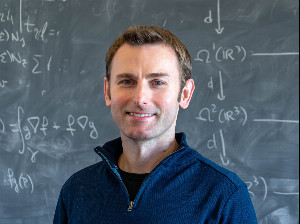Augustyniak, Maciej

- Associate Professor
-
Faculty of Arts and Science - Department of Mathematics and Statistics
André-Aisenstadt Office 4143
Courriels
Affiliations
- Membre Centre de recherches mathématiques
- Membre CRM Centre de recherches mathématiques
Courses
- ACT2241 H - Prod. dérivés, gestion de risque
Research area
- Time series
- Mathematical finance
- Computational statistics
- Markov chain
- Monte Carlo methods
- Statistical modelling
- Model selection
- Risk management
I am a researcher in actuarial science and quantitative risk management. My research aims to develop new models and methods for quantifying and managing long-term risks in actuarial and financial applications. This research program requires a multidisciplinary expertise and I therefore have research interests in different areas.
- Econometrics and computational statistics: I propose methodological and modeling contributions in the class of hidden Markov models applied to financial time series.
Keywords: hidden Markov models, regime-switching models, GARCH models, state space models, filtering techniques, particle filters, Kalman filter, EM algorithm - Quantitative finance: My objective is to study and develop techniques to more effectively manage long-term financial risks.
Keywords: quadratic hedging, variance-optimal hedging, mean-variance hedging, local risk-minimization, dynamic programming - Actuarial science: I aim to analyze and improve the effectiveness of hedging strategies used in the context of financial products sold with investment guarantees, known as segregated funds, variable annuities or equity-linked investments.
Keywords: risk management, dynamic hedging, variable annuities, equity-linked life insurance, segregated funds, model risk, lapse risk, stochastic volatility, stochastic interest rates
Moreover, I also want to establish research collaborations with the industry and professional actuarial associations. For example, I participated in collaborative research projects in partnership with AutoritÿFD des marchÿFDs financiers, National Bank of Canada, PwC Canada and the Society of Actuaries.
Dear students, you are welcome to contact me to undertake graduate studies under my supervision. I can supervise you for a master or doctoral research thesis. Alternatively, you can participate in one of my collaborative research projects with the industry.
Student supervision Expand all Collapse all
Abstract
Abstract
Abstract
Abstract
Abstract
Research projects Expand all Collapse all
Improving hedging effectiveness in actuarial and financial applications CRSNG/Conseil de recherches en sciences naturelles et génie du Canada (CRSNG) / 2023 - 2029
Centre de recherches mathématiques (CRM) FRQNT/Fonds de recherche du Québec - Nature et technologies (FQRNT) / 2022 - 2029
Quantitative Trading in North American Power Markets MITACS Inc. / 2021 - 2021
Modeling regime changes to improve portfolio diversification and performance MITACS Inc. / 2018 - 2019
Automated Transaction Classification Using Machine Learning Algorithm. MITACS Inc. / 2017 - 2017
Modeling and segmentation of the customer lifetime value in the banking industry CRSNG/Conseil de recherches en sciences naturelles et génie du Canada (CRSNG) / 2016 - 2016
CENTRE DE RECHERCHES MATHEMATIQUES (CRM) FRQNT/Fonds de recherche du Québec - Nature et technologies (FQRNT) / 2015 - 2023
ECONOMETRICS, MODEL UNCERTAINTY AND RISK MANAGEMENT IN ACTUARIAL APPLICATIONS CRSNG/Conseil de recherches en sciences naturelles et génie du Canada (CRSNG) / 2015 - 2023
SOA Educational Institution Grant Society of Actuaries / 2015 - 2018
Selected publications Expand all Collapse all
Modeling macroeconomic series with regime-switching models characterized by a high-dimensional state space 170, 122-126 (2018), , Economics Letters
Hedging variable annuities: How often should the hedging portfolio be rebalanced? 71, 1-7 (2018), , Society of Actuaries Risk & Rewards
Maximum likelihood estimation of the Markov-switching GARCH model based on a general collapsing procedure 20(1), 165-188 (2018), , Methodology and Computing in Applied Probability
A new approach to volatility modeling: the factorial hidden Markov volatility model , (2018), DOI: 10.1080/07350015.2017.1415910, Journal of Business & Economic Statistics
Assessing the effectiveness of local and global quadratic hedging under GARCH models 17(9), 1305-1318 (2017), , Quantitative Finance
Risk management of policyholder behavior in equity linked life insurance 84(2), 661-690 (2017), , Journal of Risk and Insurance
Mitigating interest rate risk in variable annuities: An analysis of hedging effectiveness under model risk 21(4), 502-525 (2017), , North American Actuarial Journal
Maximum likelihood estimation of the Markov-switching GARCH model based on a general collapsing procedure
Risk management of policyholder behavior in equity-linked life insurance
On the importance of hedging dynamic lapses in variable annuities 66, 12-16 (2015), , Society of Actuaries Risk & Rewards
Hedging interest rate risk in variable annuities
Maximum likelihood estimation of the Markov-switching GARCH model 76, 61-75 (2014), , Computational Statistics & Data Analysis
Maximum likelihood estimation of the Markov-switching GARCH model
Inference for a leptokurtic symmetric family of distributions represented by the difference of two gamma variates
An out-of-sample analysis of investment guarantees for equity-linked products: Lessons from the financial crisis of the late-2000s
An out-of-sample analysis of investment guarantees for equity-linked products: Lessons from the financial crisis of the late-2000s 16(2), 183-206 (2012), , North American Actuarial Journal
Inference for a leptokurtic symmetric family of distributions represented by the difference of two gamma variates 82(11), 1621-1634 (2012), , Journal of Statistical Computation and Simulation
